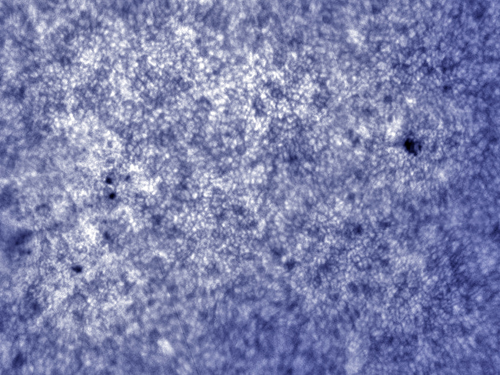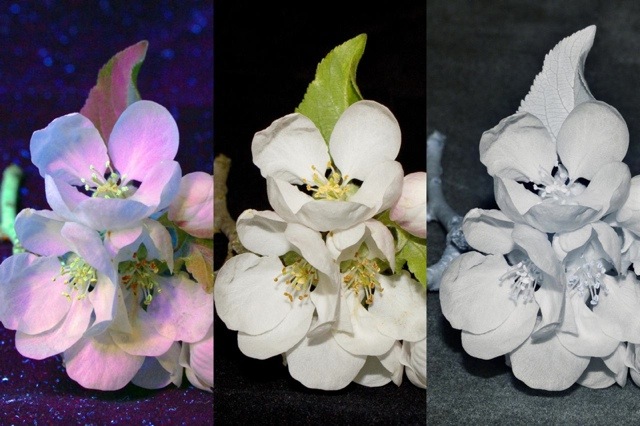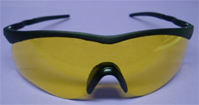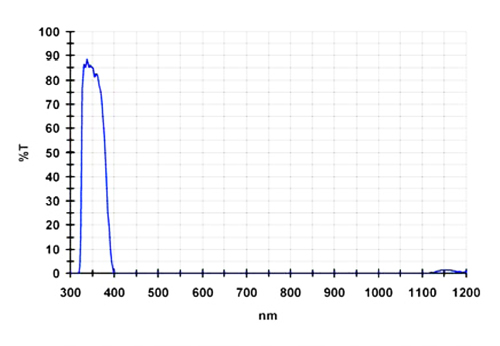Distribution
![]() News
News
![]() Notes & Interesting Articles
Notes & Interesting Articles
![]() Overview
Overview
![]() Pricing
Pricing
![]() Products
Products
Accessories and Options
![]() Filters
Filters
![]()

Baader Planetarium U–Filter BPU2 (UV or Venus Filter)

The BPU2 filter is a ultraviolet bandpass filter made so that only light in the 320 to 390 nm portions of the spectrum are transmitted; aside from this region it will effectively block all else spanning from 200 nm to 1120 nm in the infrared. This U–Filter has improved transmission peaking with 85% transmission at 350nm with a 70nm bandwidth, and with a 5 stop reduction in the IR portion of the spectrum. This replaces the original U–Filter (BPU125) that was discontinued in 2007.
Right: Baader 2 inch U–filter BPU2 (57,544 bytes).
Click on image to see enlarged view (103,501 bytes).
This filter is sold by Company Seven to customers who have a suitable telescope or UV–A capable lens. Suitable telescopes can include reflecting telescopes of 8 inch (20 cm) or larger apertures, or refractive and catadioptric telescopes employing refractive elements made of UV grade fused silica this will include our fused silica Long Distance Microscopes that can provide resolution down to the sub–micron level. The filter can also be employed with specialized camera lenses most notably the famous Nikon UV–105 F4.5 lens, a limited production conventional and macro lens with high performance spanning from 220 nm in the Ultraviolet to 900 nm in the Infrared. Note the BPU2 is only made available in 2 inch diameter filter thread, so we recommend ordering this with our custom Mark 1 adaptor ring to all the filter to be employed on the 52mm thread of the
Filters take away but they can not add - diminishing parts of the spectrum
How Are These Constructed?
The filter is made with a disc of high grade Schott UG-11 optical filter glass that has been precisely ground to be plane parallel and then polished until very smooth. The glass undergoes a vacuum deposition coating process where a forty layers micron–thin coatings of various elements are applied one upon another in a precise order and thicknesses.
The filter element is housed in a machined aluminum cell, retained by a machined thread–in ring. The filter name, size and part number are in silver, and this mirror like print when combined with its small size make this information difficult to read under dim red lighting. Company Seven recommends our customers keep these filters in well organized accessory cases, so that you know which filter is which. It helps to become familiar with how the elements appear too (read descriptions below).
The Baader U–Filter is furnished in a machined cell of 2 inch (50.8 mm) diameter so that it may be threaded onto some 48 mm female threaded hardware including nosepieces of our UV capable CCD or cameras, or sensors. Company Seven can provide adapters that permit the attachment of this filter in line in most other systems too including the popular 52 mm threading.
When viewed parallel to the eye from the female threaded (or field) side, then the filter element appears like a dark gold mirror. When looking from the male threaded (instrument) end then the filter element appears like a deep green colored mirror. For those pursuing UV imaging with digital cameras, then it is possible to unthread the retaining ring and reverse the orientation of the filter element in the cell so that the gold surface faces the camera sensor.
The coatings are calculated to transmit desired wavelengths while simultaneously rejecting all other wavelengths from 200 to 1,500 nm that would otherwise be typically passed by the UG–11 glass alone.
What Does This Do For Me?
Before the availability of this filter amateurs interested in UV applications resorted to stacking simpler interference filters, or the use of deep violet colored filters. These techniques attenuate the transmission of the desired wavelengths making these techniques possible only for highly sensitive equipment, ideally employed at higher elevations where there is less atmospheric filtering of UV. And many of these earlier techniques still passed portions of the spectrum beyond that which is desired. And with so many elements in line thereby the filter stacks accumulated errors from less than perfect optical surfaces. These handicaps diminished image brightness, contrast and definition.
The Baader U–Filter makes it possible to obtain photographs, CCD or video images in the UV–A spectral region – a wavelength coverage that up until recently was impractical for most amateur astronomers and amateur photographers. This filter provides highly efficient rejection of wavelengths outside the spectral region between 320 nm to 390 nm (photographically speaking, this is a span of about –3 stops), and this improves contrast.
Left: Venus with U-Filter. Image was taken by Baader Planetarium employee Mr. M. Rietze (9,674 bytes).
The accompanying image at left is the first test photograph of Venus. This image was taken by Baader Planetarium employee Mr. M. Rietze just two days before the Venus transit of 4 June 2004. The image clearly reveals the cusps enclosing two-thirds of the planet's circumference; a cusp extension is an effect seen at twilight caused by sunlight being diffused by the planet's atmosphere. We generally consider cusps visible to beyond half the planet disc circumference to be visible only in very good observing conditions with proper equipment.
The U–Filter passes the Calcium–K line but not in so narrow a bandpass or in the quantity that we recommend alone it in place of a specialized filter such as those made by Calcium K–Line filter. With a large aperture system, and when used in combination with other filters to reject excessive heat energy that could otherwise fry a component, then we can see some applications for studying the atmospheric torch and flare structures across the Sun's disc.
so that we might reveal what is otherwise obscured...
- UV–A is associated with aging of the skin by unprotected exposure to sunlight. When the skin cells' DNA is damaged by UV radiation then Apoptosis (Type I cell death) is triggered and the skin is replaced; malignant melanoma may occur as a result of indirect DNA damage when the damage is not properly repaired. Proper repair occurs in the majority of DNA damage therefore not every exposure to UV results in cancer. While Earth's atmosphere provides some protection the exposure to both UV-A and UV-B increases by ten percent (10%) for every 1,000 feet rise in elevation. Residents of those areas of Earth where ozone has been depleted suffer from greater exposure hence a higher percentage of skin and eye damage including cancers.
The Black Light and the Wood's Lamp are among the more common manmade sources of UV–A, these are used for hobby and entertainment effects with most sources peaking anywhere between 370 to 450nm. All reptile lamps emit UV–A while some lamps may emit a moderate amount of UV–B too; these are used in terrariums to maintain pet health. While the human eye can not see most of the radiation emitted by a Black Light certain colors and pigments absorb the invisible light then discharge it appearing as a glowing effect. The eerie appearance of posters when observed under UV are one example of this effect. Detergents may contain as much nine percent (9%) phosphorus content, the phosphors absorb UV radiation then expels them as light so that white fabrics shine brilliantly under a Black Light.
- Medium wave UV–B is a higher energy electromagnetic radiation than UV–A hence it can penetrate deeper into the skin. This increases the likelihood of skin cells DNA absorbing this energy and being modified or destroyed and because of this the letter "B" in UV–B has been associated with "burn" as in sunburn. The amount of UV–B that penetrates the atmosphere to ground level at the equator has historically been about 1,000 times greater than that at the poles. But every one percent (1%) decrease in the ozone layer of the atmosphere results in a two percent (2%) increase in UV–B exposure and a four to six percent (4–6%) increase in carcinoma. Additionally, a correlation between incidence of squamous cell carcinoma of the eyes conjunctiva and exposure to UV–B ultraviolet light has been noted; this can be a local disease process or metastasize to become fatal.
There are Black Light sources employing MgSrAl10O17, Ce phosphors that emit as low as 310 nm peak. Medium wave UV–B sources certain bodily fluids to luminesce so crime scene investigators and forensic laboratories employ these to detect blood, saliva, semen, and other fluids. Medium wave Black Lights are also used to detect anti–counterfeit markers in currency and have many other security applications including screening for counterfeit currency. The U–Filter is not intended for work in the UV–B.
- Most of the natural short wave UV–C radiation emitted by the Sun is absorbed in the Earth's atmosphere so most human exposure to UV–C will originate in artificial sources including Low–Pressure Mercury Arc Lamps. Short wave ultraviolet radiation can also cause sunburn. Short wave ultraviolet is almost completely stopped by most forms of glass or plastic, so quartz (fused silica) or special glasses must be used in the manufacture of short wave light tubes so that the short wave UV–C radiation can pass out of the tube. Short wave ultraviolet is the most popular illumination source for observing mineral fluorescence and phosphorescence producing this in perhaps ninety percent (90%) of fluorescing minerals. The U-Filter is not intended for work in the UV–C.
A short wave UV–C sterilizing tube lamps emits radiation that is destructive enough to purify water of living contaminants and to sterilize medical equipment. It has a variety of industrial uses and is considered “germicidal”.
- The glass elements used to make the Baader Filters are free of striae, optically finely polished plane parallel to within 30 seconds of arc. This eliminates any double images or ghosting due to wedge errors in the glass. These filters tend to far supersede the quality of common color filter elements which are flame polished. The combination of their fine optical craftsmanship and a comparatively thin profile allows these filters to be inserted anywhere into the optical path without introducing astigmatism or other noticeable defects into the image.
- The U–Filter will thread into conventional slip fit accessories with 2 inch threading. Company Seven offers the custom Mark 1 adaptor ring to adapt the filter for work on lenses with the 52mm thread.
- Stackable filters: each filter cell incorporates both a male and a female thread to allow stacking the filters to obtain even narrower passbands or special effects.
- The filter cells feature the largest clear aperture of any 2 inch filters on the market for complete freedom from vignetting at any focal length. The front crown of the cell incorporates milled notches which makes handling and threading the filter an easy operation.
For protection, each filter is provided with its own transparent plastic case. We are astonished however, that as outstanding as the filters are, plastic case latch tend to fail sometimes even when new. Company Seven therefore offer optional third party cases. And for the most discriminating clients, we even offer a custom made wood accessory case described below.
- It is best to protect the filter from sharp edges or any item that could cause a scratch or abrade the glass.
- When not in use, store the filter in a its provided rigid container, and it may help you to keep them organized in a fitted carrying case.
- Dew may form on the filters, if this happens do not store a wet filter into its airtight container for long periods of time; whenever possible let the filter "dry out" in order to reduce the potential for problems developing associated with Fungus, etc.
- Draw any large, loose bits of foreign matter from the surface of the glass with an air bulb or small vacuum. Stubborn particles can be removed with a soft camel's hair brush. Throughout the year, but especially in cold climates when static become more of a problem we particularly recommend the use of a Staticmaster brush.
- Place a few drops of an approved lens cleaning solution (by Carl Zeiss or Kodak) or mild soap solution of clear dish washing liquid diluted with distilled water onto a cotton swab. Then gently wipe in a circular motion with little or no pressure. The filter can be damaged if there are tiny abrasive particles on the surface which are pressed in by rubbing hard.
 Sunspot by Dominique Dierick in Belgium |
 Granularity on the Sun by Dominique Dierick in Belgium |
Table Above: images of the Sun taken on same day by Dominique Dierick in Belgium. Baader energy rejection filter at front combined with a Baader U pass filter
and economical DMK CCD camera on a 130 mm (5.1 inch) apochromat refracting telescope.
Click on each image to see the enlarged view.
Since most lenses, telescopes, and eyepieces can not pass light much below about 365 nm in the UV the U–Filter is recommended for use only with optics and cameras (CCD astro camera, webcam or digital SLR with UV lens or telescope) that can record light in the UV spectrum.
The U–Filter is not a visual filter since the human eye can not resolve images clearly in these portions of the spectrum transmitted by this filter.
And particularly if attempting to observe the Sun with these filters there are health issues involved.
UV light is electromagnetic radiation with a wavelength shorter than that of visible light (400 to 700 nm), yet longer than x-rays. UV is considered to span the range from 10 nm to 400 nm. For a representation of the range of uses where the Nikon 105 UV lens is suitable (from 220 to 900 nm) see the following spectrum chart. Note for reference we also show where the Fraunhofer lines (A to K) typically of interest to telescope and lens designers correlate on the spectrum below:

Above: Table above expresses visual spectrum, ultraviolet (below 380 nm), near infrared (above 700 nm)
and optical properties including color correction in Nanometers at various Fraunhofer color lines (C to K).
 For fun: flower blossoms in UV, visible, IR light |
 Catching bad guys: scratches in UV, visible, IR light |
Images courtesy of R. Horsnell. Click on images to see enlarged views (260,042 and 136,271 bytes).
WARNING Infrared and ultraviolet wavelengths are invisible to the human eye yet these electromagnetic waves bear energy and other information. So any structure that absorbs the light can be damaged by this energy; note how sunlight exposure tans the skin while prolonged exposure fades or breaks down materials. The photons of shorter wavelength carry greater energy therefore, these have the greater potential for causing biological damage. These wavelengths can penetrate the eye or skin cells and can produce heating and energy related biological changes that will modify or destroy cellular DNA; this is among the reasons why some UV light sources are used for germicidal (sterilizing) apparatus. It is generally agreed by the medical community that the human eye should not be exposed to light in these portions of the spectrum since this can cause severe damage of the cornea, lens, and retina.
Lifetime cumulative exposures can also be contributing factors in the development of cataracts, pterygium, or conjuctiva. If you still have any doubts just consider the statistics showing dramatic increases of eye problems of residents living in ozone depleted areas of the southern hemisphere!
As amazing as it can be to explore the ultraviolet spectrum, this is not child’s play therefore:
 it is vital that suitable eye safety protection be used when working in the proximity of UV light sources.
it is vital that suitable eye safety protection be used when working in the proximity of UV light sources.

Though all Black Lights emit UV rays, they can be used for different purposes depending on their wavelengths within the UV range. Wavelengths are measured in nanometers (one billionth of a meter) with the UV spectrum generally falling between 100 and 380 nm. This spectrum is divided into three categories:
| Utraviolet Spectrum Sectors | ||||||||||||||||
|
UV–A, UV–B, UV–C:
The long wave UV–A and medium wave UV–B are the types of naturally occurring ultraviolet light that a person is most likely to encounter on Earth. UV-C is encountered only when generated by artificial sources.
Filters are used to block portions of the spectrum that we do not wish to use, so keep in mind that filters take away but can not add anything. For the best results in certain astronomical applications, or for terrestrial UV–A imaging and photography Company Seven recommends UV transmission filters most notably the U-Filter; sometimes referred to as the 'UV' or 'Venus Filter'.
Right: Baader U2 (Venus) Filter UV-A transmission curve (55,334 bytes).
Click on image to see enlarged view (105,400 bytes).
For terrestrial applications the UV light sources include flash, lamp systems, fluorescent, or LED; the best choice depends on the intended application (UV–A, UV–B, UV–C) and whether or not the subject could be altered or damaged by heat from some sources. A lamp shade or other blocking device should be considered to better focus the light onto a target and reduce stray light. The lighting sources for field photography or forensics applications should be portable and able to run off of batteries, or the lighting may be AC powered lamp(s). There are light systems made specifically for UV, you will find information about suppliers for minerals studies, etc. on the Internet. It is not a simple matter to adapt conventional light sources for use in the UV since commercial lights usually do not emit sufficient UV to register through the UV Transmission Filter. Of course safety gear (goggles, etc.) will also be associated with the use of most light sources. So you may want to organized a 'UV Kit' and keep it cased and ready to go.
Please contact us for advice that may be more specific to your requirements.
Features Of The Baader Filters:
The optional wood case is foam lined with cutaway spaces for filters, eyepieces and other small accessories for your telescope. Please refer to our price list for current prices for the filter set and the optional case or contact Company Seven for more information.
Right: optional wood box for Filter Set (52,803 bytes)
Click on the image to see enlarged view (190,049 bytes).
FURTHER READING
Contents Copyright 2007-2016 Company Seven All Rights Reserved


